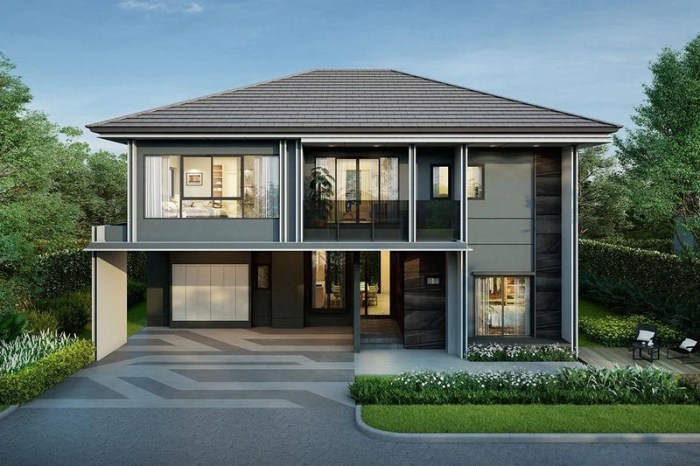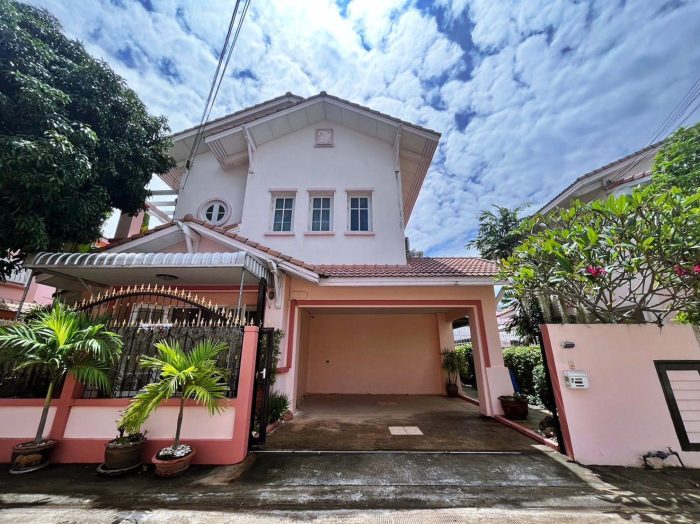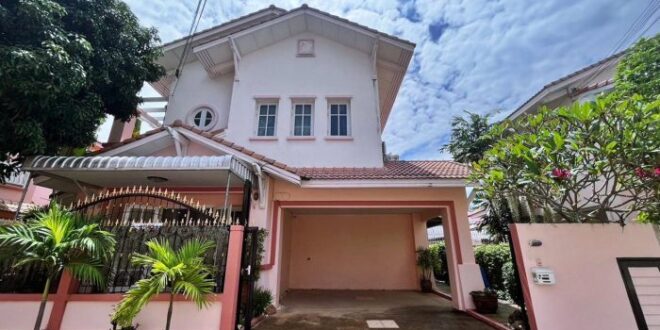House for rent in Thailand – it’s all about finding the perfect pad, right? From bustling Bangkok to chilled-out Chiang Mai, the Thai rental market’s a jungle out there. This guide breaks it down, covering everything from average costs to snagging the perfect deal.
We’ll dive into the rental market trends, explore regional variations in costs, and reveal the different property types on offer. Plus, we’ll give you the lowdown on navigating rental agreements and finding your dream pad in Thailand.
Overview of Rental Market in Thailand

The Thai rental market, a significant component of the real estate sector, demonstrates diverse trends across different regions. Factors like economic conditions, tourism, and local demand heavily influence rental prices and availability. This overview provides a snapshot of the current market, highlighting regional variations and common rental terms.The rental market in Thailand is dynamic, with prices fluctuating based on location and property type.
The interplay of factors like tourism, local demand, and economic conditions is a key element in understanding these fluctuations. This report details the key characteristics of the rental market, offering insights into current trends.
Rental Costs Across Regions
Rental costs vary significantly across Thailand’s major cities. Bangkok, a bustling metropolis, typically commands the highest rental rates due to its high demand and limited housing supply. Chiang Mai, a popular tourist destination and university city, presents a more moderate range, while Phuket, a prominent tourist hub, exhibits similar characteristics to Bangkok with high rental rates in prime locations.
| Region | Average Rent (THB) | Property Type | Typical Lease Terms |
|---|---|---|---|
| Bangkok | 40,000 – 100,000+ | Apartments, Condos, Townhouses | 1 – 2 years, often renewable |
| Chiang Mai | 10,000 – 30,000 | Apartments, Houses, Villas | 1 – 3 years, negotiable |
| Phuket | 20,000 – 80,000+ | Apartments, Villas, Beachfront properties | 1 – 2 years, usually with options for renewal |
The table above provides a general overview. Actual rental costs can vary based on factors like the size and condition of the property, amenities, and location within the city.
Types of Housing Available
A wide range of housing options is available for rent in Thailand. Apartments and condominiums are prevalent, particularly in urban areas like Bangkok. Houses and villas are more common in suburban areas and tourist destinations like Phuket and Chiang Mai. These options often differ significantly in terms of amenities and size, directly impacting the rental price.
Common Rental Agreements and Terms
Rental agreements in Thailand typically include details regarding rent, security deposit, lease duration, and payment schedule. Negotiation is often part of the process, and understanding the standard terms and conditions is crucial for both landlords and tenants. Legal contracts are essential to protect the rights of both parties. It is strongly advised to have a lawyer review any rental agreement before signing.
Lease Duration and Renewal
Lease agreements in Thailand generally range from one to three years, with options for renewal. The specific duration is negotiable between the landlord and tenant, and is often dependent on the location and type of property. Understanding the legal frameworks and terms for renewals is vital.
Factors Influencing Rental Costs

Rental costs in Thailand, like elsewhere, are complex and influenced by a multitude of factors. Understanding these elements is crucial for both renters and landlords to make informed decisions. From the sought-after location to the quality of amenities, numerous variables contribute to the final rental price.Understanding the interplay of these factors helps navigate the rental market effectively, allowing for better budgeting and a more informed comparison of properties.
Factors such as location, size, amenities, condition, demand, and supply all play a role in determining the overall rental price.
Location’s Impact on Rental Costs
Location is arguably the most significant factor affecting rental costs. Properties situated in prime areas, near transportation hubs, shopping centers, or tourist attractions, typically command higher rental rates. For instance, apartments in bustling areas like Sukhumvit or Riverside Bangkok will often have higher rental prices compared to those in quieter residential neighborhoods. This is due to the increased demand for convenient and accessible locations.
Size and Amenities’ Influence on Rental Costs
Property size and included amenities also significantly influence rental costs. Larger apartments, houses, or condos with extra space for living, working, or entertaining, generally have higher rental prices. Similarly, properties equipped with premium amenities such as swimming pools, gyms, or 24-hour security, will typically command higher rates than comparable properties lacking these features. A condo with a rooftop pool and fitness center will likely have a higher rental price than a similar condo without these amenities.
Condition and Features Impacting Rental Costs
The condition of the property is another key determinant. Well-maintained properties, modern fixtures, and updated facilities typically fetch higher rental prices. Similarly, properties with a good view, secure parking, and good natural lighting are often more expensive. A newly renovated condo in a prime location with a balcony will typically have a higher rental price than an older condo in the same area.
The Role of Demand and Supply
The dynamic interplay between demand and supply plays a critical role in shaping rental rates. High demand for rental properties in a specific area, particularly during peak seasons, can lead to higher rental prices. Conversely, a high supply of properties in a particular area might lead to lower prices. For example, a sudden influx of new condominiums in a neighborhood might cause a temporary decrease in rental rates, whereas if there’s a limited number of available units, the rates could increase significantly.
Rental Cost Comparison by Property Features
| Property Feature | Number of Bedrooms | Number of Bathrooms | Parking | Rental Cost (Estimated THB/month) |
|---|---|---|---|---|
| Condominium in Sukhumvit | 1 | 1 | No | 15,000-25,000 |
| Condominium in Sukhumvit | 2 | 2 | Yes | 25,000-40,000 |
| House in a quiet residential area | 3 | 2 | Yes | 30,000-50,000 |
Note: Rental costs are estimates and can vary significantly based on specific locations, amenities, and property conditions. The table provides a general comparison and should not be considered a definitive guide.
Types of Properties Available
The Thai rental market offers a diverse range of properties to suit various needs and budgets. From cozy apartments to spacious villas, understanding the different types available is crucial for finding the right fit. This section details the features and amenities commonly found in each type, along with examples to illustrate the spectrum of options.
Apartment Rentals
Apartments are a popular choice for renters seeking convenience and proximity to city centers. They typically feature modern kitchens, bathrooms, and living areas, often including amenities like swimming pools, fitness centers, or parking. Studios, one-bedroom, and two-bedroom apartments are common, with sizes and layouts varying significantly depending on location and the building’s design. Luxury apartments in Bangkok, for example, might offer panoramic city views, concierge services, and high-end finishes.
Budget-friendly options, especially in suburban areas, might have smaller layouts and basic amenities.
House Rentals
Houses offer more space and privacy than apartments. These rentals often include yards, gardens, and more flexible floor plans. Single-family homes, townhouses, and detached houses are among the common types. Features might include separate dining rooms, large living areas, and dedicated spaces for hobbies or entertaining. Houses can vary significantly in size, from small, affordable homes in smaller towns to expansive estates in upscale neighborhoods.
For example, a budget-friendly option in a residential area might feature a small garden and a basic kitchen, while a more luxurious house in a gated community might include a swimming pool, a home theater, and a staff room.
Villa Rentals
Villas are typically larger, freestanding properties, often found in more secluded or rural areas. They provide a high level of privacy and a spacious living environment. Villas are often suitable for families or groups looking for more space and amenities. They frequently feature private pools, gardens, and multiple bedrooms. Luxury villas can include multiple living areas, home theaters, and staff quarters.
Examples of budget-friendly villas can be found in areas with less developed infrastructure, but still offer a significant amount of space and privacy compared to apartments.
Comparison of Property Types
| Property Type | Features | Amenities | Price Range (Approximate) |
|---|---|---|---|
| Apartments | Modern kitchens, bathrooms, living areas, varying sizes | Swimming pools, fitness centers, parking (often included) | ฿5,000 – ฿50,000+ per month |
| Houses | Yards, gardens, separate rooms, various sizes | Garages, storage, private gardens | ฿10,000 – ฿100,000+ per month |
| Villas | Large, freestanding properties, often with private pools | Private pools, gardens, multiple bedrooms, large living spaces | ฿20,000 – ฿500,000+ per month |
Note: Prices are approximate and can vary significantly based on location, size, and amenities.
Finding Rentals in Thailand
Finding the right rental property in Thailand can be a rewarding experience, but navigating the process requires understanding the local market and utilizing effective resources. Thorough research and careful consideration of your needs and preferences are crucial to securing a suitable rental that meets your expectations.Navigating the rental market in Thailand involves understanding the various online platforms, steps to follow, and how to effectively filter your search.
This section details the process of finding rentals, highlighting key aspects of the search to make it efficient and successful.
Common Online Platforms for Rentals
Several online platforms facilitate the search for rental properties in Thailand. These platforms offer listings for various types of properties, from apartments and houses to villas and condos. They often feature detailed descriptions, photos, and contact information, streamlining the process for potential renters.
- Property websites like PropertyGuru, 99.co, and others offer extensive listings.
- Social media groups and forums dedicated to rental properties are valuable resources, particularly for finding local deals and insights.
- Local real estate agents often maintain websites or profiles on online platforms, providing access to properties not always listed publicly.
Steps in Searching for a Rental Property
The process of finding a rental involves several steps, from initial research to property visits and negotiations.
- Define your needs and preferences. Clearly Artikel your budget, desired location, preferred property type, and essential amenities (e.g., parking, swimming pool, proximity to schools or work).
- Use online platforms to conduct an initial search. Explore various websites and platforms, inputting your criteria to generate a list of suitable properties.
- Thoroughly review listings. Pay attention to details such as property size, amenities, and surrounding areas. Carefully examine photographs to assess the property’s condition and layout.
- Contact landlords or agents. Initiate communication with the relevant parties to inquire about available properties and schedule viewings.
- Visit properties in person. Inspect the property, ensuring it meets your requirements and aligns with your expectations.
- Negotiate terms and conditions. If interested, discuss and negotiate rental terms, including lease agreements and payment methods.
Filtering Results Based on Specific Criteria
Filtering results based on specific criteria like budget, location, and amenities is crucial for narrowing down your search effectively. The more detailed your filters, the more relevant results you’ll obtain.
- Budget: Specify a price range for your rental to avoid viewing properties outside your financial capacity.
- Location: Set geographical boundaries or proximity to desired areas to streamline your search to your ideal location.
- Amenities: Specify desired amenities such as swimming pools, parking, or proximity to public transportation to match your preferences.
Understanding the Local Rental Market
A thorough understanding of the local rental market is vital. This involves research into typical rental costs, property availability, and popular areas.
- Local rental costs vary by location. Research different neighborhoods to understand the prevailing rates and to select the area that aligns with your budget.
- Seasonal fluctuations in rental availability may occur. Be aware of seasonal changes in rental market conditions.
- Property types available vary by location. Understand the different types of properties offered in the area to choose the option that best suits your needs.
Popular Rental Websites and Platforms
Several online platforms facilitate the search for rental properties in Thailand. These platforms provide comprehensive listings, often with detailed descriptions, photos, and contact information.
| Website/Platform | Description |
|---|---|
| PropertyGuru | A popular international real estate platform with extensive listings. |
| 99.co | A Southeast Asian platform with a substantial collection of listings. |
| [Local Real Estate Portals] | Specific websites focusing on local listings and rental markets. |
| [Social Media Groups] | Groups dedicated to rentals often provide valuable local insights. |
Negotiating and Signing a Lease
Securing a rental property in Thailand involves navigating the lease agreement meticulously. Understanding the negotiation process, common clauses, necessary documents, and potential pitfalls is crucial for a smooth and successful tenancy. Thorough preparation and awareness of your rights will protect you from unforeseen issues.Negotiating rental terms and conditions is a critical aspect of securing a property in Thailand.
It often involves discussion of the rental amount, deposit, payment schedule, lease duration, and specific property features. Flexibility and a clear understanding of the market rates are key to successful negotiation.
Negotiating Rental Terms
Rental negotiations typically begin with a discussion of the rental price. Researching comparable properties in the area and understanding the current market rates is essential to establish a fair and reasonable offer. Communicating your needs and budget to the landlord or their representative is vital. The negotiation process often involves compromises and adjustments to reach a mutually agreeable price.
Common Lease Clauses
Lease agreements in Thailand often include clauses concerning rent, payment methods, security deposits, maintenance responsibilities, and termination provisions. Understanding these clauses is crucial to avoid future disputes.
- Rent: The lease agreement must specify the exact amount of rent, frequency of payment (e.g., monthly), and acceptable payment methods. Late payment penalties should be clearly defined.
- Security Deposit: A security deposit is usually required and serves as a guarantee against damages or unpaid rent. The agreement should clearly Artikel the conditions for its return.
- Maintenance Responsibilities: Clarify who is responsible for routine maintenance and repairs of the property. This clause should detail who is responsible for which types of maintenance (e.g., plumbing issues, electrical problems).
- Lease Duration: The agreement should state the duration of the lease, specifying the start and end dates. Consider the possibility of lease renewals or extensions. Short-term leases are common for tourists and those planning to stay for a specific period. Longer-term leases offer greater flexibility for those looking to stay for an extended time.
- Termination Provisions: The agreement should clearly Artikel the procedures for terminating the lease, including notice periods, penalties for early termination, and the conditions for termination due to unforeseen circumstances.
Essential Documents
A comprehensive set of documents is essential for a legally sound rental agreement. These documents protect both the tenant and the landlord.
| Document | Description |
|---|---|
| Lease Agreement (Sankhya): | A legally binding contract outlining the terms and conditions of the rental agreement. It should be written in Thai and English for clarity. |
| Copy of Identification: | Valid identification documents of both the tenant and landlord are crucial for verification purposes. |
| Payment Receipts: | Maintain copies of all rent and deposit payment receipts. |
| Proof of Address: | Proof of address, such as utility bills, is essential for verification and registration. |
| Property Inspection Report: | A comprehensive inspection report documenting the property’s condition upon move-in is crucial for any future disputes. |
Common Pitfalls to Avoid
Rushing into a lease agreement without thoroughly reviewing the terms and conditions can lead to problems. Understanding the nuances of Thai rental law and seeking legal advice when necessary are vital steps.
- Lack of Thorough Review: Carefully review every clause of the lease agreement to understand your obligations and rights.
- Ignoring Local Laws: Ensure the lease adheres to Thai rental laws and regulations.
- Inadequate Documentation: Maintain complete records of all communications, payments, and property inspections.
- Failure to Negotiate: Negotiate rental terms and conditions to ensure a fair agreement for both parties.
- Unclear Communication: Ensure clear and transparent communication with the landlord or their representative to avoid misunderstandings.
Living in a Thai Rental Property
Navigating the rental market in Thailand requires understanding local customs and regulations. This section details the cultural nuances, available services, responsibilities of both landlords and tenants, and the significance of local laws. Understanding these aspects ensures a smoother and more satisfying rental experience.
Cultural Considerations
Thai culture places high value on respect and harmony. When interacting with landlords and neighbours, maintaining a polite and courteous demeanor is essential. Small gestures of appreciation, such as a simple “thank you” or a small gift, can foster positive relationships. Addressing landlords with formal titles like “คุณ” (Khun) demonstrates respect. Understanding the concept of “saving face” is also crucial; avoiding public disputes or complaints is generally preferred.
The pace of life in Thailand is often more relaxed than in some Western countries, and patience is key in resolving issues or waiting for responses.
Local Services and Amenities, House for rent in thailand
Rental properties in Thailand often vary in proximity to essential services. Common amenities include convenience stores, local markets, and transportation options such as buses and taxis. For those living in urban areas, access to hospitals, schools, and shopping malls is usually good. The availability of amenities can vary depending on the location of the rental property. Factors like proximity to public transport, parks, and recreational areas should be considered when selecting a rental.
Landlord and Tenant Responsibilities
Clear understanding of responsibilities between landlords and tenants is vital for a harmonious rental agreement. Thai law often dictates these responsibilities, and the lease agreement should clearly Artikel these details. Failure to adhere to these Artikeld responsibilities may result in legal consequences.
The transient nature of a house for rent in Thailand, a place of vibrant life and fleeting connections, often mirrors the ephemeral nature of human existence. The passing of loved ones, as documented in resources like Young’s Community Memorial Funeral Home & Cremation Services obituaries , reminds us of the constant cycle of loss and renewal. Ultimately, the search for a suitable rental in Thailand, like life itself, involves navigating these complexities with a sense of adaptability and resilience.
Importance of Understanding Local Laws and Regulations
Thai rental laws, while often aligned with common sense principles, require careful consideration. A tenant should thoroughly review the lease agreement to understand their obligations and the landlord’s responsibilities. This includes the duration of the lease, payment schedules, deposit procedures, and the process for handling disputes. Familiarising oneself with local regulations, including property taxes and tenant protection laws, is crucial for a secure and compliant rental experience.
Securing a rental house in Thailand necessitates careful consideration, especially concerning the often-complex insurance landscape. Navigating the process of changing insurance companies, as detailed in this resource ( how do i change insurance companies ), can be crucial for renters seeking optimal protection and peace of mind. Ultimately, understanding these procedures is paramount when searching for the perfect Thai rental home.
For instance, understanding the procedure for terminating a lease contract is essential for both parties.
Landlord and Tenant Responsibilities Summary
| Responsibility | Landlord | Tenant |
|---|---|---|
| Payment of Rent | Ensure rental amount is accurate and clearly stated in the lease. | Pay rent on time as per the lease agreement. |
| Property Maintenance | Maintain the structural integrity of the property and common areas. | Report any damages or issues promptly to the landlord. |
| Utilities | Provide information on utility costs and responsibilities. | Pay utility bills according to agreed-upon terms. |
| Security | Ensure the property is adequately secured. | Respect the property’s security measures. |
| Legal Compliance | Adhere to all relevant Thai rental laws. | Understand and comply with all lease terms and Thai laws. |
| Dispute Resolution | Establish a process for resolving disputes. | Use the established dispute resolution process. |
Illustrations of Thai Rental Properties
Thai rental properties showcase a diverse range of styles and features, reflecting the country’s rich architectural heritage and modern influences. From traditional Thai-style homes to contemporary apartments, the choices cater to a variety of tastes and budgets. Understanding the visual characteristics of these properties is crucial for prospective renters to make informed decisions.
Types of Rental Properties
Thai rental properties encompass various types, each with unique characteristics. These range from charming bungalows nestled in lush gardens to modern high-rise apartments in bustling city centers. The diversity reflects Thailand’s diverse landscape and urban environments.
- Traditional Thai-style Homes: These properties often feature intricately carved wooden details, high ceilings, and open-plan layouts. Exterior walls might be adorned with traditional Thai motifs, creating a sense of authenticity. Inside, wooden floors, ornate furniture, and handcrafted decorations often add to the aesthetic. The living room frequently opens to a courtyard or garden, maximizing natural light and air flow.
- Modern Apartments: These properties, particularly in urban areas, often emphasize sleek lines, modern appliances, and efficient layouts. They typically offer comfortable living spaces with well-designed kitchens and bathrooms. Amenities such as swimming pools, fitness centers, and security systems are commonly found in high-rise apartment complexes. The interiors often feature contemporary furniture and decor, with an emphasis on practicality and functionality.
- Bungalows: These freestanding homes, often found in residential areas, provide a more private and spacious living experience. They can range from simple, modest structures to elaborate designs with ample gardens and outdoor living spaces. Many bungalows feature private gardens, offering a tranquil retreat from the city’s bustle. The layout often includes a separate kitchen, living room, and bedrooms, providing a degree of privacy.
Interior Features
The interior design of Thai rental properties reflects the country’s cultural heritage and modern influences. Key elements contribute to the overall aesthetic and functionality.
- Living Rooms: Living rooms in traditional homes might incorporate large, ornate furniture and intricate wall hangings. Modern apartments often feature comfortable sofas, flat-screen televisions, and sleek coffee tables, with an emphasis on a contemporary design. The layout frequently connects the living room to the dining area and kitchen for a seamless flow.
- Kitchens: Kitchens in traditional homes may be more modest in size, with open shelving and handcrafted cabinets. Modern kitchens, however, are typically well-equipped with modern appliances such as refrigerators, stoves, and dishwashers, offering functionality and convenience. Counter space and storage are also critical elements in modern kitchens.
- Bedrooms: Bedrooms in Thai-style homes often feature comfortable beds and traditional Thai-style furniture. Modern apartments, conversely, typically include comfortable beds, bedside tables, and ample storage space. Natural light and ventilation are often prioritized in the design of bedrooms, promoting a peaceful atmosphere.
Exterior Features
Exterior features play a crucial role in creating the overall appeal and ambiance of a Thai rental property.
- Gardens: Gardens are common features in Thai rental properties, especially in bungalows and detached homes. They often include lush greenery, flowering plants, and sometimes ponds or small water features. Landscaping design can range from minimalist to elaborate, with a focus on creating a peaceful and inviting outdoor space.
- Courtyards: Courtyards are a common element in Thai-style homes. They often serve as a transition space between the interior and exterior, providing a secluded area for relaxation and enjoying the outdoors. Courtyards can be designed with various elements, such as fountains, trees, and seating areas, to enhance the experience.
Visual Characteristics of Various Properties
The table below provides a concise overview of different Thai rental property types and their visual characteristics.
| Property Type | Exterior | Interior |
|---|---|---|
| Traditional Thai-style Home | Intricately carved wooden details, traditional Thai motifs on walls, courtyards or gardens. | Wooden floors, ornate furniture, handcrafted decorations, open-plan layouts. |
| Modern Apartment | Sleek design, high-rise buildings, often with communal amenities. | Modern appliances, well-designed kitchens and bathrooms, contemporary furniture and decor. |
| Bungalow | Freestanding home, often with private gardens and outdoor living spaces. | Separate kitchen, living room, and bedrooms, potentially offering a more spacious layout. |
Conclusion
So, you’re ready to rent a house in Thailand? This guide has covered the basics, from understanding the market to signing that all-important lease. Remember to do your research, compare prices, and always read the small print. Good luck finding your perfect Thai pad!
FAQ Insights: House For Rent In Thailand
What are the average rent prices in Bangkok compared to Chiang Mai?
Bangkok tends to be significantly more expensive due to higher demand and more amenities. Chiang Mai offers a more budget-friendly alternative, but quality can vary.
What are the common lease terms in Thailand?
Most leases are for a year, but you can often negotiate shorter or longer terms. Make sure you understand the specific terms and conditions Artikeld in the contract.
What are some common online platforms for finding rentals in Thailand?
There are various websites and platforms, but some popular ones include local real estate agents’ websites and international portals. Check reviews and compare before settling on a site.
What are some common pitfalls to avoid during the lease process?
Always read the lease carefully, confirm all details with the landlord, and ensure you understand all fees. Be wary of any unexpected charges and get everything in writing.
 Nimila
Nimila




